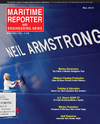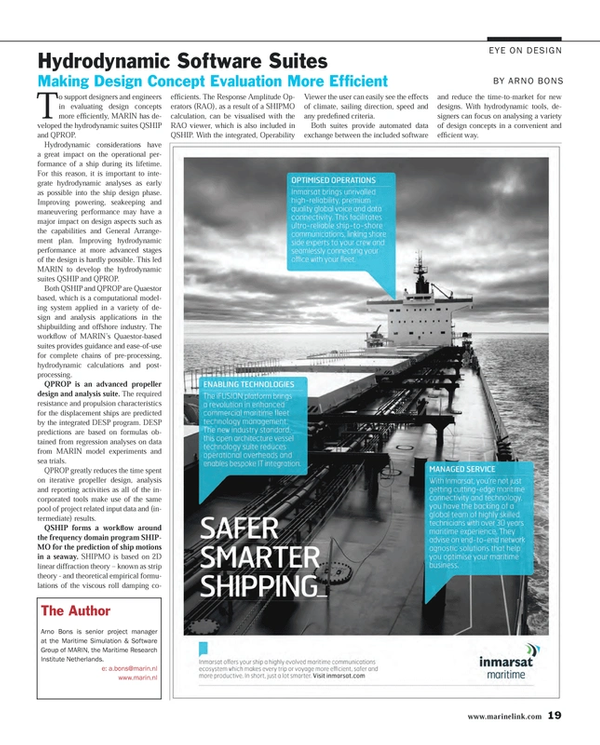
Hydrodynamic Software Suites
Making design concept evaluation more efficient
To support designers and engineers in evaluating design concepts more efficiently, MARIN has developed the hydrodynamic suites QSHIP and QPROP.
Hydrodynamic considerations have a great impact on the operational performance of a ship during its lifetime. For this reason, it is important to integrate hydrodynamic analyses as early as possible into the ship design phase. Improving powering, seakeeping and maneuvering performance may have a major impact on design aspects such as the capabilities and General Arrangement plan. Improving hydrodynamic performance at more advanced stages of the design is hardly possible. This led MARIN to develop the hydrodynamic suites QSHIP and QPROP.
Both QSHIP and QPROP are Quaestor based, which is a computational modeling system applied in a variety of design and analysis applications in the shipbuilding and offshore industry. The workflow of MARIN’s Quaestor-based suites provides guidance and ease-of-use for complete chains of pre-processing, hydrodynamic calculations and post-processing.
QPROP is an advanced propeller design and analysis suite. The required resistance and propulsion characteristics for the displacement ships are predicted by the integrated DESP program. DESP predictions are based on formulas obtained from regression analyses on data from MARIN model experiments and sea trials.
QPROP greatly reduces the time spent on iterative propeller design, analysis and reporting activities as all of the incorporated tools make use of the same pool of project related input data and (intermediate) results.
QSHIP forms a workflow around the frequency domain program SHIPMO for the prediction of ship motions in a seaway. SHIPMO is based on 2D linear diffraction theory – known as strip theory - and theoretical empirical formulations of the viscous roll damping coefficients. The Response Amplitude Operators (RAO), as a result of a SHIPMO calculation, can be visualised with the RAO viewer, which is also included in QSHIP. With the integrated, Operability Viewer the user can easily see the effects of climate, sailing direction, speed and any predefined criteria.
Both suites provide automated data exchange between the included software and reduce the time-to-market for new designs. With hydrodynamic tools, designers can focus on analysing a variety of design concepts in a convenient and efficient way.
The Author
Arno Bons is senior project manager at the Maritime Simulation & Software Group of MARIN, the Maritime Research Institute Netherlands.
e: [email protected]
www.marin.nl
(As published in the May 2014 edition of Maritime Reporter & Engineering News - http://magazines.marinelink.com/Magazines/MaritimeReporter)
Read Hydrodynamic Software Suites in Pdf, Flash or Html5 edition of May 2014 Maritime Reporter
Other stories from May 2014 issue
Content
- New Concept Eliminating Crude Oil Spill Spread page: 10
- BOS Provides 2-5% Fuel Savings page: 10
- Floating Production System Orders Outlook page: 12
- The Treatment of Foreign Seafarers page: 16
- Hydrodynamic Software Suites page: 19
- SEEMP: Potential Win-win for Commercial Vessels page: 20
- Ergonomic Controls Innovation for ECDIS, Bridge Controls page: 22
- To Litigate, or Arbitrate? That is the Question page: 24
- Experts Weigh Training Factor into Sewol Tragedy page: 26
- Does e-Learning Work? page: 30
- Elmer A. Sperry: Pioneer of Modern Naval Tech page: 32
- Aviator & Engineer: Lawrence Burst Sperry page: 38
- U.S. Navy's AGOR 27: R/V Neil Armstrong page: 40
- Classification Leaders Weigh in on Marine Propulsion page: 44
- Interview: Rich Hobbie, Water Quality Insurance Syndicate (WQIS) page: 48
- Mammoet: World’s Biggest Crawler Crane Installs Legs on Ship page: 52
- ALP Tugs Get Rolls-Royce Deck Equipment page: 52
- Traction and Control System for Tugboat Winches page: 53
- Townsville Opts for a Liebherr LHM 420 page: 53
- WASSP Goes Wireless with New Remote Mapping System page: 55
- Danelec’s 3G VDR page: 55
- ABB Energy Management System page: 55
- Transas Liquid Cargo Handling Simulator page: 55
- Color LCD Radar from SI-TEX page: 55
- Martek: Network-Connected ECDIS page: 55
- Vessel Optimization Data page: 55
- Lilaas L01 Control page: 56
- Northport Actisense Engine Monitoring Units page: 56
- MarineNav’s New Line of Displays page: 56
- Voyager Planning Station Adds AtoBviaC Distance Tables page: 56
- L-3 SAM for DanTysk Wind Project page: 56
- Navis Joystick System for New Yacht page: 56
- Ship-to-Turbine Oil Change System page: 57
- USN Orders Hoffer Flow Measurement Systems page: 57
- Phoenix Launches HDL-LED Series page: 57
- New Line of Safety Switches page: 57
- HAL Retrofits VDRs on Fleet page: 57
- New Steering System page: 57


